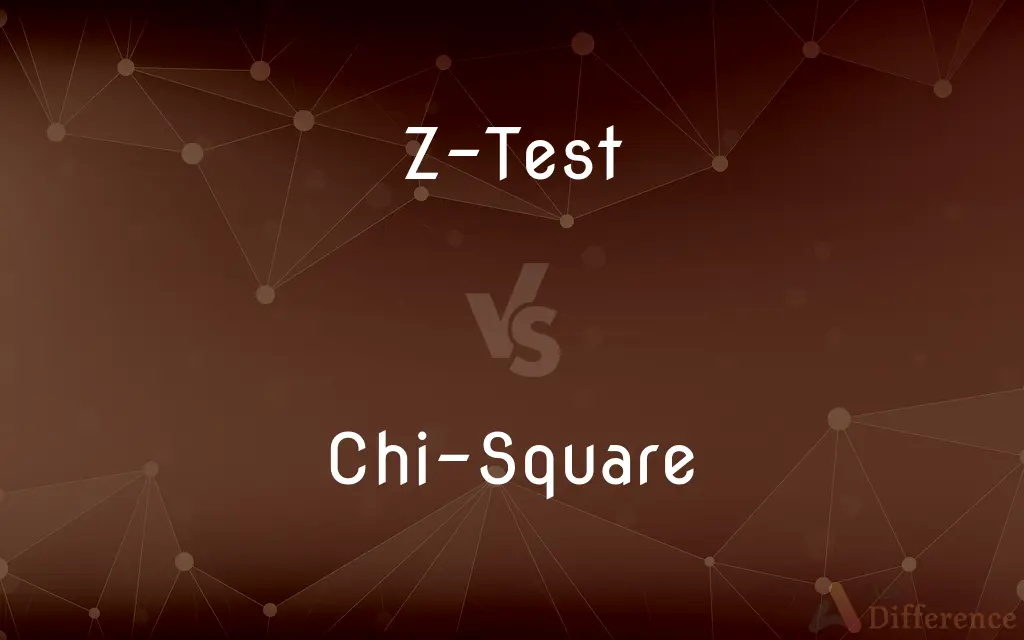Z-Test vs. Chi-Square — What's the Difference?
Edited by Tayyaba Rehman — By Fiza Rafique — Published on December 23, 2023
Z-Test determines the difference between a sample mean and a population mean, while Chi-Square tests the association between categorical variables.

Difference Between Z-Test and Chi-Square
Table of Contents
ADVERTISEMENT
Key Differences
Z-Test is a statistical test that primarily focuses on comparing means. Specifically, it's employed when one wants to know if a sample's mean is significantly different from a known population mean. Given that the population standard deviation is known, Z-Test can effectively discern this difference. On the other hand, Chi-Square is a test of independence or association. It measures if there is a significant association between two categorical variables, making it highly applicable in contingency table analyses.
Both Z-Test and Chi-Square are integral in hypothesis testing. However, where Z-Test deals with means and requires knowledge of the population standard deviation, Chi-Square examines relationships between categorical variables. The latter does this by comparing the observed frequencies in different categories with the frequencies one would expect under certain assumptions.
In practice, a researcher might use a Z-Test to determine if a new teaching method has led to different test scores for a group of students, comparing it to a population mean. In contrast, the same researcher could use Chi-Square to see if there's an association between gender and preference for a teaching method among a group of students.
Consequently, while Z-Test and Chi-Square can sometimes be used in tandem, their primary functions in research are distinct. The former handles means, and the latter, categorical variables. Both, however, enable researchers to draw meaningful conclusions from data.
Comparison Chart
Primary Purpose
Compare sample mean to population mean
Test association between categorical variables
ADVERTISEMENT
Data Type
Continuous
Categorical
Requirements
Known population standard deviation
Observed & expected frequencies
Example Use Case
Comparing test scores to a national average
Examining link between smoking and lung disease
Test Statistic Distribution
Z distribution (standard normal distribution)
Chi-Square distribution
Compare with Definitions
Z-Test
Requires knowledge of the population's standard deviation.
The Z-Test was applicable as the population standard deviation was known.
Chi-Square
Tests association between categorical variables.
Using Chi-Square, we checked the relation between diet and disease incidence.
Z-Test
Assesses if differences are statistically significant.
The Z-Test confirmed the observed differences were not by chance.
Chi-Square
Compares observed to expected frequencies.
The Chi-Square showed a significant difference between observed and expected counts.
Z-Test
Utilizes the standard normal distribution.
The Z-Test results were mapped on a Z distribution curve.
Chi-Square
Applicable for contingency table analyses.
The 2x2 table was perfect for a Chi-Square test.
Z-Test
Pertains to continuous data.
We employed a Z-Test to compare the heights of two groups.
Chi-Square
Doesn't require knowledge of population parameters.
Since we lacked population means, we opted for a Chi-Square test.
Z-Test
A statistical test comparing sample mean to a population mean.
Using a Z-Test, we assessed if the drug changed average recovery times.
Chi-Square
Works with nominal and ordinal data.
Given our ordinal data, a Chi-Square seemed most fitting.
Chi-Square
A test statistic that is calculated as the sum of the squares of observed values minus expected values divided by the expected values.
Chi-Square
(mathematics) A test statistic used in the chi-square test.
Chi-Square
A journalism educator or researcher focusing on statistical methods and quantitative measurement.
Green eyeshade
Common Curiosities
Is the Z distribution the same as the standard normal distribution?
Yes, the Z distribution is essentially the standard normal distribution.
Is the Chi-Square test related to the chi-squared distribution?
Yes, the test statistic from a Chi-Square test follows the chi-squared distribution.
Is the Z-Test only for large sample sizes?
Generally, yes. Z-Test is most reliable with large samples (typically n>30).
How many variables can I test with Chi-Square?
Chi-Square tests the association between two categorical variables in its basic form.
When should I use a Z-Test over Chi-Square?
Use a Z-Test when comparing a sample mean to a population mean and the population standard deviation is known; use Chi-Square for associations between categorical variables.
What if my sample size is small for Chi-Square?
If expected counts are too low (below 5), the test may not be valid. Consider Fisher's exact test instead.
Can I use Chi-Square for continuous data?
No, Chi-Square is designed for categorical data, not continuous.
Can I use a Z-Test for independent samples?
Yes, there are versions of the Z-Test designed for comparing means from two independent samples.
What's an expected frequency in a Chi-Square test?
Expected frequency is what you'd expect if there was no association between the variables.
Why is it called a Z-Test?
It's named for its use of the Z distribution or standard normal distribution.
Do I need to know the population mean for a Z-Test?
Yes, the Z-Test compares a sample mean to a known population mean.
Can I use Z-Test for proportion comparisons?
Yes, the Z-Test can be used to compare proportions as well.
Share Your Discovery

Previous Comparison
Orbitals vs. Energy Levels
Next Comparison
Primary Immune Response vs. Secondary Immune ResponseAuthor Spotlight
Written by
Fiza RafiqueFiza Rafique is a skilled content writer at AskDifference.com, where she meticulously refines and enhances written pieces. Drawing from her vast editorial expertise, Fiza ensures clarity, accuracy, and precision in every article. Passionate about language, she continually seeks to elevate the quality of content for readers worldwide.
Edited by
Tayyaba RehmanTayyaba Rehman is a distinguished writer, currently serving as a primary contributor to askdifference.com. As a researcher in semantics and etymology, Tayyaba's passion for the complexity of languages and their distinctions has found a perfect home on the platform. Tayyaba delves into the intricacies of language, distinguishing between commonly confused words and phrases, thereby providing clarity for readers worldwide.














































